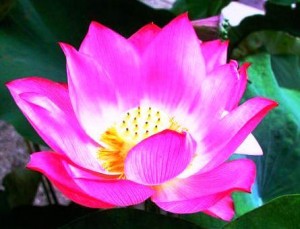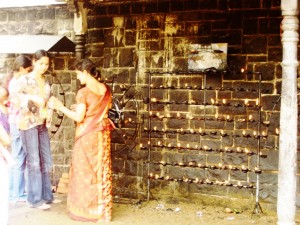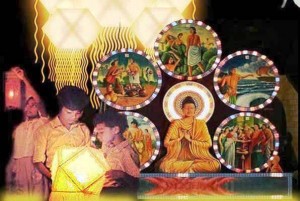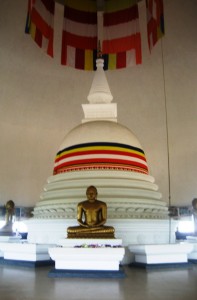Addition of Rituals to Buddhist Practices
Posted on February 27th, 2011
Article 3
Rituals in Buddhist Practices:
Buddhism is devoid of any ceremony or ritual of initiation or admission, such as the Upanayana in Hinduism or baptism in Christianity.ƒÆ’-¡ƒ”š‚ The traditional method of becoming a Buddhist is to observe the Three-Refuges (tisarana) and the Five-Precepts (paƒÆ’†’ƒ”š‚±ca-sila) with the Confidence of the Triple Gem (the Buddha, the Dhamma, and the Sangha).ƒÆ’-¡ƒ”š‚ ƒÆ’-¡ƒ”š‚ Confidence (shradhaƒÆ’†’ƒ”š‚£wa) in Buddhism is not the same as Faith (bhaktiya). In the practice of Buddhism, it is also important to understand the meanings of Buddhist stanzas that are usually recited in PƒÆ’†’ƒ”š‚£li. ƒÆ’-¡ƒ”š‚ Recitation without understanding the meaning or commitments involved serves no purpose.ƒÆ’-¡ƒ”š‚ Traditionally, the Three Refuges are delivered by a Buddhist monk, but this is not essential.ƒÆ’-¡ƒ”š‚ Three Refuges are:
Buddham saranam gacchƒÆ’†’ƒ”š‚£mi ƒÆ’‚¢ƒ¢-¡‚¬ƒ¢¢”š¬‚ I go to the Buddha for refuge.
Dhammam saranam gacchƒÆ’†’ƒ”š‚£mi ƒÆ’‚¢ƒ¢-¡‚¬ƒ¢¢”š¬‚ I go to the Dhamma for refuge.
Sangham saranam gacchƒÆ’†’ƒ”š‚£mi ƒÆ’‚¢ƒ¢-¡‚¬ƒ¢¢”š¬‚ I go to the Sangha for refuge.
This affirmation of Confidence in the Triple Gem (tisarana) is repeated for a second time (e.g., dutiyampi Buddham saranam gacchƒÆ’†’ƒ”š‚£mi, etc.), and a third time (tatiyampi…). After this, the devotee repeats the Five Precepts, which are meant as a reminder to discipline in the BuddhistƒÆ’‚¢ƒ¢-¡‚¬ƒ¢-¾‚¢s moral life.ƒÆ’-¡ƒ”š‚ ƒÆ’-¡ƒ”š‚ However, it is up to the individual to keep these moral values as taught by the Buddha.
For Buddhist devotees, the ritual of worship is nothing more than a respectful recognition of the greatness of the Buddha as a spiritual teacher.ƒÆ’-¡ƒ”š‚ ƒÆ’-¡ƒ”š‚ It is an expression of gratitude to the Buddha for having discovered and revealed the path leading to the elimination of human suffering.ƒÆ’-¡ƒ”š‚ ƒÆ’-¡ƒ”š‚ The whole affair becomes a futile exercise if the participants merely reciting stanzas in a parrot-like fashion, or does not adhere to the Five-Precepts.
Offering of Flowers:
Of the many articles of offering used during worship, flowers have become the most popular.ƒÆ’-¡ƒ”š‚ ƒÆ’-¡ƒ”š‚ Some Buddhists consider flowers a requirement in devotion to the religious conviction.ƒÆ’-¡ƒ”š‚ The colour (vanna), smell (gandha), and quality (gunƒÆ’†’ƒ”š‚£) of the flowers are taken into account when selecting them for offering.ƒÆ’-¡ƒ”š‚ ƒÆ’-¡ƒ”š‚ During the offering of flowers, devotees recite the following PƒÆ’†’ƒ”š‚£li stanza:
Vannagandha-gunopetam ƒÆ’‚¢ƒ¢-¡‚¬ƒ¢¢”š¬‚ etam kusuma-santatim
pujayƒÆ’†’ƒ”š‚£mi munindassa ƒÆ’‚¢ƒ¢-¡‚¬ƒ¢¢”š¬‚ siripada-saroruhe.
Pujemi Buddham kusumena ƒÆ’‚¢ƒ¢-¡‚¬ƒ¢-¾‚¢nena ƒÆ’‚¢ƒ¢-¡‚¬ƒ¢¢”š¬‚ punnena ƒÆ’‚¢ƒ¢-¡‚¬ƒ¢-¾‚¢metena ca hotu mokkham
Puppham milayati yatha idam me ƒÆ’‚¢ƒ¢-¡‚¬ƒ¢¢”š¬‚ kayo tatha yati vinasabahavam
This stanza means, “With this mass of flowers, endowed with colour, fragrance, and quality, I venerate the Buddha, the King of wise.ƒÆ’-¡ƒ”š‚ I worship the Buddha with these flowers: by the merit of this may I attain liberation.ƒÆ’-¡ƒ”š‚ ƒÆ’-¡ƒ”š‚ As these flowers fade and wither, so will my body, decay.ƒÆ’‚¢ƒ¢-¡‚¬ƒ”š‚ƒÆ’-¡ƒ”š‚ Importantly, this stanza incorporates the key Buddhist philosophy of the ƒÆ’‚¢ƒ¢-¡‚¬ƒ…-impermanenceƒÆ’‚¢ƒ¢-¡‚¬ƒ”š‚ (aniccƒÆ’†’ƒ”š‚£) of all material and phenomena.
Customarily, before being offered, the flowers are ƒÆ’‚¢ƒ¢-¡‚¬ƒ…-bathedƒÆ’‚¢ƒ¢-¡‚¬ƒ”š‚ with filtered water (pan). Sometimes they are arranged in a tray (vattiya) before being offered.ƒÆ’-¡ƒ”š‚ ƒÆ’-¡ƒ”š‚ What is the symbolic meaning for this?ƒÆ’-¡ƒ”š‚ ƒÆ’-¡ƒ”š‚ Flowers blooming upon contact with light and keeping fresh with a touch of water are regarded as symbolic of the attainment of Enlightenment; thus, flowers become quite a fitting offering to the Buddha, the Enlightened One.ƒÆ’-¡ƒ”š‚ ƒÆ’-¡ƒ”š‚ However, the offering of flowers is not an essential part of Confidence (shradhaƒÆ’†’ƒ”š‚£wa) or the practice of Buddhism.ƒÆ’-¡ƒ”š‚ ƒÆ’-¡ƒ”š‚ Consequently, if one has the right mental attitude, whether one offers none, one, or 1,000 flowers, it makes no difference.
Offering of Light:
Another popular offering of much importance is that of incense and lighted lamps; usually the lamps are lit with coconut oil, customarily called pahan-puja.ƒÆ’-¡ƒ”š‚ ƒÆ’-¡ƒ”š‚ The theoretical basis for this practice is that the Buddha is regarded as the “dispeller of the darkness of ignorance”; so lighted lamps are offered in his name, symbolizing the contrast between, ƒÆ’‚¢ƒ¢-¡‚¬ƒ…-achievingƒÆ’-¡ƒ”š‚ knowledge and eliminating the darkness of ignorance.ƒÆ’‚¢ƒ¢-¡‚¬ƒ”š‚ƒÆ’-¡ƒ”š‚ Consequently, whether one lights one lamp or 1000 lamps, it makes no difference.ƒÆ’-¡ƒ”š‚ What matters is the Right thought and the Right intention.ƒÆ’-¡ƒ”š‚ Understanding teachings of the Buddha, and how one can lay the path to eliminate oneƒÆ’‚¢ƒ¢-¡‚¬ƒ¢-¾‚¢s own ƒÆ’‚¢ƒ¢-¡‚¬ƒ…-ignoranceƒÆ’‚¢ƒ¢-¡‚¬ƒ”š‚ by enhancing oneƒÆ’‚¢ƒ¢-¡‚¬ƒ¢-¾‚¢s mental ability to develop Wisdom is what’s important.ƒÆ’-¡ƒ”š‚ ƒÆ’-¡ƒ”š‚ Nevertheless, this practice has often become a meaningless routine ritual.
The symbolism of lighting lamps is simply a tradition for some. ƒÆ’-¡ƒ”š‚ Their motive for this ritual is usually to satisfy the desires to acquire merit or to avert the evil influence of bad planetary actions.ƒÆ’-¡ƒ”š‚ ƒÆ’-¡ƒ”š‚ Nevertheless, the offering is supposed to remind the follower to understand the importance of ƒÆ’‚¢ƒ¢-¡‚¬ƒ…-the Wisdom versus Ignorance.ƒÆ’‚¢ƒ¢-¡‚¬ƒ”š‚ƒÆ’-¡ƒ”š‚ ƒÆ’-¡ƒ”š‚ Devotees make such offerings by reciting the following Pali stanza:
GhanasarƒÆ’†’ƒ”š‚£ppa-dittena ƒÆ’‚¢ƒ¢-¡‚¬ƒ¢¢”š¬‚ dipena tama-damsina
Tilokadipam sambuddham ƒÆ’‚¢ƒ¢-¡‚¬ƒ¢¢”š¬‚ pujayami tamonudam
This stanza means, ƒÆ’‚¢ƒ¢-¡‚¬ƒ…-With this lamp, I dispel the darkness; I venerate the perfectly Enlightened One, who is a lamp unto the three worlds and is the dispeller of the darkness of delusion.ƒÆ’‚¢ƒ¢-¡‚¬ƒ”š‚
The epithets tilokadipa (ƒÆ’‚¢ƒ¢-¡‚¬ƒ…-lamp unto the three worldsƒÆ’‚¢ƒ¢-¡‚¬ƒ”š‚) and tamonuda (ƒÆ’‚¢ƒ¢-¡‚¬ƒ…-dispeller of darknessƒÆ’‚¢ƒ¢-¡‚¬ƒ”š‚) as applied to the Buddha are significant in this context.ƒÆ’-¡ƒ”š‚ ƒÆ’-¡ƒ”š‚ The stanza itself seems to testify to the popularity of the offering of camphor (ghanasarƒÆ’†’ƒ”š‚£) in early times.ƒÆ’-¡ƒ”š‚ ƒÆ’-¡ƒ”š‚ However, today even when coconut oil has replaced camphor, the stanza continues using the same verses. ƒÆ’-¡ƒ”š‚ ƒÆ’-¡ƒ”š‚ The importance is to understand the meaning of these stanzas, and not the glory or the numbers of lamps lighted.
As per the chronicles, the offering of lighted lamps has been a popular ritual since ancient times.ƒÆ’-¡ƒ”š‚ ƒÆ’-¡ƒ”š‚ The Bodhi-tree and dagabas (also referred to as stupa, chetiya) are the two main objects or sites where this practice is usually performed.ƒÆ’-¡ƒ”š‚ ƒÆ’-¡ƒ”š‚ The offering of lamps is one of the main aspects of the worship of the Bodhi-tree (bodhi-puja). The understanding behind this is that it was under a Bodhi-tree that the Buddha attained Enlightenment.ƒÆ’-¡ƒ”š‚ ƒÆ’-¡ƒ”š‚ Thus, it is natural that lamps are lit under such trees, not only in memory of the great event, but also as a practice whereby the devotee can expect to obtain a ray of that light of Wisdom attained by the Great Sage.ƒÆ’-¡ƒ”š‚ ƒÆ’-¡ƒ”š‚ Thus, this practice can be considered a spiritual exercise.ƒÆ’-¡ƒ”š‚ ƒÆ’-¡ƒ”š‚ Devotees then transfer the obtained merits to humans, deities, and deceased relatives.
Offering to Dagabas:
Dagaba (chaitya) is another place where offerings are made.ƒÆ’-¡ƒ”š‚ ƒÆ’-¡ƒ”š‚ Consequently, along with the flower altars, the lamp stands have become accessories of the dagaba. One can also see these around Bo-trees in most temples.ƒÆ’-¡ƒ”š‚ ƒÆ’-¡ƒ”š‚ Platforms of special lamp stands are built with metal, brick, or stone, and places are made to hold oil lamps. ƒÆ’-¡ƒ”š‚ In some Buddhist temples, there is a special lamp, called the dolosmahe-pahana (12-month lamp), which is expected to keep burning year-round; it is a special symbol for Spiritualism and Wisdom.
It has also become customary for some to perform the ritual of light offering (pahan-puja) to counter evil planetary influences.ƒÆ’-¡ƒ”š‚ ƒÆ’-¡ƒ”š‚ Coconut oil that is used for illuminating, is at times specially prepared for the occasion, and wicks are prepared from a clean, white, fresh cloth.ƒÆ’-¡ƒ”š‚ ƒÆ’-¡ƒ”š‚ Sometimes an entire village or group of people or an organization holds a mass lamp offering, during which 84,000 lighted lamps are offered in memory of the 84,000 elements of the Dhamma (dhammakkhandha) comprising the BuddhaƒÆ’‚¢ƒ¢-¡‚¬ƒ¢-¾‚¢s teaching.ƒÆ’-¡ƒ”š‚ ƒÆ’-¡ƒ”š‚ Whether such practices are considered a social event or a spiritual event depends on the understanding and the motives of the people who organize and participate in such events.
Another ritual is to have special light or illumination offerings made on auspicious occasions.ƒÆ’-¡ƒ”š‚ ƒÆ’-¡ƒ”š‚ As a part of the homage to Buddha, on special occasions such as full moon days, person’s birthday, fulfilling a ƒÆ’‚¢ƒ¢-¡‚¬ƒ…-vowƒÆ’‚¢ƒ¢-¡‚¬ƒ”š‚ (bƒÆ’†’ƒ”š‚£raya), or on Vesak Day (to celebrate the birth and the Enlightened of the Buddha), flowers are offered and oil lampsƒÆ’-¡ƒ”š‚ are lighted.ƒÆ’-¡ƒ”š‚ ƒÆ’-¡ƒ”š‚ Devotees offer a large number of lamps for these special occasions.
Some Buddhist rituals have been practiced since ancient times in Sri Lanka. ƒÆ’-¡ƒ”š‚ For example, King Dutugemunu (2nd century B.C.) is recorded to have lit 1,000 lamps with ghee as the lamp fuel; these lamps had white wicks and burned perpetually in 12 sacred places in Anuradhapura (Mhv.ƒÆ’-¡ƒ”š‚ xxxii, 37).ƒÆ’-¡ƒ”š‚ ƒÆ’-¡ƒ”š‚ King Vasabha (1st century A.C.) is said to have lit 1,000 oil lamps at Cetiyapabbata, Thuparama, Mahathupa (Ruvanweli-dagaba) and the Bodhi-tree (Mhv.ƒÆ’-¡ƒ”š‚ ƒÆ’-¡ƒ”š‚ xxxvi, 80).
Today, this ritual has become so popular and elaborate that the annual Vesak festival, commemorating the birth, Enlightenment, and Parinibbana of the Buddha, has become more or less a ƒÆ’‚¢ƒ¢-¡‚¬ƒ…-festival of lights,ƒÆ’‚¢ƒ¢-¡‚¬ƒ”š‚ but in many cases has lost the spiritual meaning. ƒÆ’-¡ƒ”š‚ Vesak lanterns of various kinds, colour, and shapes are lit in Buddhist establishments and in homes, on this day.ƒÆ’-¡ƒ”š‚ ƒÆ’-¡ƒ”š‚ Large decorated and illuminated structures (thoran, pandols) are illuminated with multi-coloured electric bulbs, depicting various scenes from the life of the Buddha and from the Jataka stories.ƒÆ’-¡ƒ”š‚ These have become an important social venture in some Buddhist countries.
Rituals are not a part of authentic Theravada Buddhism.ƒÆ’-¡ƒ”š‚ ƒÆ’-¡ƒ”š‚ For various reasons, over the years, these artefacts have been brought into the practice of Buddhism.ƒÆ’-¡ƒ”š‚ The next article (#4) will further review the rituals and realistic approaches to Buddhism.
ƒÆ’‚¢ƒ¢-¡‚¬ƒ…-All conditioned things are impermanent; when one sees this with Wisdom, then one becomes dispassionate toward the painful (samsara): this is the Path to PurityƒÆ’‚¢ƒ¢-¡‚¬ƒ”š‚ (Dhammapada)
Note: Some of the material, pictures, and poems have been published previously or obtained from the Internet (e.g., http://what-buddha-said.net; Buddha.Direct.net, etc.) and other sources, and modified, reproduced with approval.ƒÆ’-¡ƒ”š‚ ƒÆ’-¡ƒ”š‚ The author sincerely thanks all contributors of such materials for their generosity.
PS:ƒÆ’-¡ƒ”š‚ This and the next article (#4) are written in response to the discussions in the article number 2.
We hope that these brief articles on meditation, Buddhism, and Buddhist philosophy will initiate healthy and positive discussions.
May the Noble Triple Gem bless you
Sunil J. Wimalawansa




February 27th, 2011 at 12:11 am
UPANAYANA is for Brahmans only and not for all Hindus.
further Sanga which has destroyed the buddhism in India. Bhikkus like Somarama or others part of sanga. Further the selfish motives of Bhikkus destroyed Buhhism.
How can we justify sanga in the case of speacial privilages in trains and busses?
February 27th, 2011 at 2:33 pm
Mudali & Others: I guess we see what you are referring to. Some Sanga are very good (especially the forest Sangha) and doing what they are suppose to do (i.e., meditation, spiritual life, and teaching and spreading Dhamma, etc.), while the others are not. However, without the “Sangha”, there want be any Sasana, and its preservation for the benefits of the future generations. May be that you and some others have some specific ideas and suggestions to overcome the current (negative) issues. Can we re-establish the respectability and the venerability of the Sangha? What are the solutions you are proposing to overcome the issues you mentioned?
February 27th, 2011 at 5:20 pm
Prof SW,
You are asking the wrong person! Our friend Mudali is only interested in ridiculing the Sasana and Buddhism and shown that it is the fault of Buddhism and Buddhists that his Tamil Ealm didn’t become fruition.
February 27th, 2011 at 5:40 pm
Prof SW,
In the past kings invited Burmese and Thai monks to uplift the Sasana. Today it is not possible. In my view, we have to go back to Lord Buddha’s teachings to find a way to uplift the Sasana and the Buddhists. Wonders of meditation has been researched around the world. Modern Buddhism should take up these and promote meditation in the society. Yoga has been promoted very well. Why not Buddhist meditation which is supposed to be far more superior and intellectually stimulating.
Emphasis on understanding the teachings should be made over giving too much emphasis on statues, etc. It can be done especially in today’s world where religious dogma has reducing support. Young educated people around the world want an understandable “religion” where thier “destiny” can be controlled by them and the uncontrollable specified clearly. Buddhism is the ideal “religion” for that. Once again nothing has been done to make use of this development to promote the teachings of Buddha.
Unitary Sri Lanka must be protected as it is to protect Buddhism. Divisions means the country where Theravada has survived for so long will disappear without a trace. Buddhism should remain supreme in SL constitution.
Eroding Buddhism based SL values should be rekindled. These can create a tangible benefit in the society people will like. political leaders should quote Buddha teachings in their speeches, ceremonies, etc. and relate the little good they do to teachings.
Buddhists are the poorest people in SL. Their economy should be uplifted at all cost. Unlike other gods based religions, teachings and logic based religions don’t prosper in poverty. Gods may give them money but teachings don’t even promise anything like that. So economic prosperity of Buddhists at all cost should be prioritised. Poverty also pushes people to various gods for help.
Above all practical methods to save SL and hence Buddhism should be taken. Unlike other religions, Buddhism doesn’t allow practical guidance to face terrorist, war threats. That doesn’t mean we should not do these. Common sense, not Buddhist teachings, should prevail. Our kings knew this very well.
Prabakaran had said he would not have taken up his gun had JR been a good Buddhist. This is total rubbish. He took up the gun before JR became the national leader. His beliefs of Buddhism is that when faced with demands, Buddhists should give them all so that there is no need for confrontations! That is such a dumb belief. He paid a heavy price for his stupidity.
February 27th, 2011 at 8:25 pm
Mudali ( son of IPKF) ,
It is Tamils and few more racial south Indian races who distroyed the Buddhism in India.
“Sangha” word is reserved for the proper Bikkhus. “Sanga” is the shortened name of Sangakkara.
February 27th, 2011 at 8:57 pm
lets all put the hand in our own bossom; people are instrumental for the corruption of Buddhism, they expect others to do things for them. Monks often struggle to practise the right way, but cant reach nibbana for other people. “great monks” have bussness intrests, and people see the wealth of the as a result of good kamma, so they help them to get more wealth. the organized theistic churches collect money collectively and do wellfare work with it they call it missionairy work. Rich orders and temples sit on their money and recite their mantra of ; “mamma. matte, mage!”. Give the young monks who want to practise the right way your support to do so.
There are so many young monks who want to do it right! only they dont get a chance. the feodal system stops them and later they become trapped in the system. so sad!!!
February 27th, 2011 at 9:00 pm
by the way; I think that one of the greatest miracles of Buddhism is that there are still so many young people who want to be a monk and follow the difficult live as a monk! for them a Sadhu, Sadhu Saaa!!!!
February 28th, 2011 at 1:25 am
Addition of Rituals to Buddhist Practices –
By Prof. Sunil Wimalawansa – DEAR LEARNED PROFESSOR WOULD YOU KINDLY ENLIGHTEN US ALL THAT WHERE IN THE LORD BUDDHA’S TEACHINGS IS IT FOUND THAT HE RECOMMENDS CONSTRUCTING STATUES OF HIS LIKENESS & OFFERING FLOWERS TO THESE STATUES – AS FAR AS I KNOW HE ONLY RECOMMENDED FOLLOWING THE MIDDLE PATH. I SINCERELY BELIEVE THAT THESE FUNDS SPENT ON ERECTING STATUES & PICKING FLOWERS WHICH HITERTO GRACE THEIR PLANTS & SHURBS BE RATHER SPENT ON FEEDING & HELPING THE POOR AND NEEDY BEARS MORE MERIT.
February 28th, 2011 at 8:00 am
Thanks to Prof. Wimalawansa for venturing into this important topic.
Here is our view on mattters, venturing beyond rituals, humbly submitted for whatever it is worth. I am going to address some practical realities we are facing.
(1) Religions are formed after the Teacher/Master passes away. All kinds of rituals are formed by the devotees who are keen to honor the Teacher. There is no harm in this at all, except that when Rituals are excessive, they replaces the Teachings. The Christians celebrate Christmas to honor Jesus Christ, but this festival has now been ‘stolen’ by the Markets of the world, and the Master’s teachings quite forgotten in feasts, the World Wars I&II, and other wars. Some people abroad put notices in their gardens at X’mas time saying : “Bring Christ back to Christmas”.
Likewise for Muslims, the teachings of Mohamed are forgotten in so called Jihads etc. when Islam means “Peace”. These ‘Jihads’ may be on the way out now with M.E. uprisings. Some Hindu people try to maintain the Caste structures. It was to maintain the worker/slave structure of Dalits/Untouchables that Hinduism took root over Buddhism (which did not recognise the Untouchable System) in India. So all the religions have basically ‘failed’ in some way or the other.
In our view, the rituals & chanting, however enchanting, do not do much to raise the Consciousness of the practitioner, in any religion, particularly when chanting is done in beautiful but dead languages. Perhaps some of the basic gathas can be recited in Sinhala ? Just trying to make sense of ritual here, no offence meant. Pirith is right in Pali, but translations in Sinhala/Tamil/English should be provided. It may take away some of the hidden mysticism, but at least the words would have meaning & purpose. However, the different Buddhist Meditations bring great benefits to the practitioner. That is how China & Japan flourish. Meditation & Contemplation are invaluable assets in Buddhist Teachings.
(2) Buddhists never went to war to ‘preserve’ Buddhism. Whenever they went to war, it was for their very survival ! Like the Hindus, they do not actively convert people to their religion either. Usually, they simply want the peace required to practice their religion, as any genuine practitioner of any religion would. As a result of this somewhat passive approach, they tend to lose the land & sea areas that is rightfully theirs. They have to get more savvy on how to manage their material world and not leave it to others to do so. Laws must be put in place to govern/safeguard everything material. And do it ourselves, and not depend on others to write these Laws. It is pointless complaining “after the horses have fled the stables”.
(3) Regarding so-called Buddhist past priests Somarama & Buddharakhitha, someone has to clarify what went wrong there. What was the childhood & upbringing of these two people that made them so different to the usual Buddhist priest ? Bring it out in the open and lay the matter to rest.
(4) We agree that the Poor & Needy Buddhists should be looked after by Buddhists. This should be done by Buddhist Organisations (not Temples). Active fund raising has to be done for this purpose, and accounting done by a reputed accountancy firm. Also, Counselling and other functions with the ordinary people should be done by LAY Buddhist priests as someone suggested earlier. Lay ‘priests’ should have different attire than the yellow robe (a yellow collar round the neck ?), and they should be allowed to marry. Alternatively or additionally, as in Thailand, youth (both male & female) should be allowed to enter the Sasana for an year or two, on a temporary basis, to learn the Teachings of the Buddha properly, and then enter society. They too should have a different attire.
(5) FAMILY PLANNING should be encouraged by all religions.
The above written as a lay persons view on matters, with offence to none. My All be Well & Happy !
February 28th, 2011 at 9:54 pm
Great ideas. Thank you Lorenzo for educating us. There is no reason why Sri Lankans or others should not adopt the concept of temporary monkhood, as routinely practice in Thailand. Imaging politicians becoming monks for few months! What a transformation for the county.
It is worth thinking why almost all Theravada Buddhist countries are “materially” and economically poor; as Lorenzo pointed out, discrepancy even within Sri Lanka. Poverty is one of the key factors for targeting such vulnerable populations for conversion. Overcoming such needs persistent, lot of grass root activities. Whether it is time for a “Sangayana” to harmonize various groups and to eliminate artificially annexed non-Buddhist practices to Buddhism, need serious attention.
Meanwhile, Terrence pointed out several issues that dilute the value of True Buddhism. It is “people” who are to be blamed with such short-sighted approaches, and alienating monks (e.g, providing luxuries items, TV/DVDs, etc.). We need to discuss these and address such with open mindness.
Fran Diaz has lots of good ideas. Certain temples have extra-ordinary amounts of wealth, while others have nothing. Some monks in rural temples wouldn’t even get a decent meal. Why such discrepancy? Can the ‘wealthy temples’ take care and assist the other temples and poor people? How can we persuade Mahanayakas to visit rural temples and initiate “excitement” among the lay public on Buddhism, propagate peace and healthy activities?
There are grass root level charitable foundations dedicated for empowering poor people at village level, that Fran mentioned. These include but not limited to Center for Buddhist Activities (CfBA), Hela Bodhu Padanama (HBP), etc.; but regrettably, people make no donations to these and pay no attention to their honorable activities.
March 1st, 2011 at 5:47 am
Please permit me further comment & suggestions. Whilst generating ideas, I would like to emphasize that ordinary people will go where a genuine good feeling is felt and help is given with good will, just for the joy of giving. To this end, Volunteers are invaluable.
Buddhist organisations which are scattered all over Lanka in a kind of haphazard way should be properly re-organised. Usually, the prime objective of a Buddhist organisation is the dissemination of the Dharma. The scope should be universally widened to include helping the Buddhist poor, teaching of skills, teaching of English, finding/creating jobs etc. In fact, be the traditional “YMBA”/”YWBA”.
(1) Buddhist organisations, large or small, must be brought under one umbrella & supervised by one organisation (YMBA Head Office in Colombo, or ACBC ?). Even the smallest Buddhist organisation should have Accounts kept of the inflow & outflow of funds donated. Simple Book Keeping may be done by hand written accounts with notes where necessary. There is no need for complicated book keeping. People will donate funds only if there is TRANSPARENCY in accounting for money donated. The Accounts book should be displayed for the public to see at a convenient place, preferably away from the Temple itself. An Annual simple Balance Sheet should be submitted to the main Buddhist organisation.
* Temple funds should be separate from the Buddhist Organisation funds. I am not sure whether the Monks should also keep simple accounts of their funds received.
* Each Buddhist Temple itself could teach the Dharma & Meditation.
(2) Each Province should have a group of respected Monks & Buddhist Elders to conduct the Buddhist activities of that Province.
(3) Simply written booklets of the core Teachings of the Buddha should be made available free of charge. This should be done in all three languages.
(4) The Buddhist poor MUST be helped in education, job seeking & counselling through the ‘yellow collar’ monks who could be resident in every Province, Such ‘lay monks’ could work together with the Buddhist organisations in each Province.
Readers, please feel free to criticize, add or subtract to above ideas.
March 2nd, 2011 at 12:57 pm
Furthermore, Co-operatives should be formed by Buddhist Associations, not so much as retail shops, but as farming & food production units. These units could be for fund raising as well as employment. In USA, Co-operatives form over 15% of total business activity in USA.